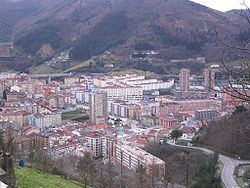Elevation 121 m Population 27,440 (2014) Local time Wednesday 12:26 AM | Autonomous community Basque Country Website Official website Area 24.78 km² Clubs and Teams SD Eibar, JD Arrate | |
 | ||
Weather 13°C, Wind W at 11 km/h, 91% Humidity | ||
Eibar (Basque: Eibar, Spanish: Éibar) is a city and municipality within the province of Gipuzkoa, in the Basque Country of Spain. It is the head town of Debabarrena, one of the comarcas of Gipuzkoa.
Contents
- Map of 20600 Eibar GuipC3BAzcoa Spain
- Geography
- History
- Main sights
- Transport
- Education
- Sport
- Famous people
- References
Map of 20600 Eibar, Guip%C3%BAzcoa, Spain
Eibar has 27,439 inhabitants (INE, 2013). Its chief industry is metal manufacturing, and has been known since the 16th century for the manufacture of armaments, particularly finely engraved small arms. It was also the home of Serveta scooters.
It is home to the SD Eibar football team in La Liga.
Geography
Eibar lies at an altitude of 121m above sea level, in the west of the province of Gipuzkoa, right next to Biscay. Eibar has an oceanic climate. The town lies in a narrow valley in a mountainous area, the highest mountains are between 700 and 800 metres high. Eibar is traversed by river Ego, which is a tributary of the Deba.
Apart from the urban area, the municipality consists of five rural neighbourhoods: Otaola-Kinarraga, Aginaga, Arrate, Mandiola and Gorosta.
History
The city was chartered by Alfonso XI of Castile in 1346, receiving the name of Villanueva de San Andrés de Heybar.
The feudal families that dominated the territory engaged in the War of the Bands. Eibar, like the rest of settlements in the valley, had an industry based on finery forges and the manufacture of arms. In 1766, Eibar got engaged in a social revolt known as the Machinada, and years later, in 1794, it was attacked by the French, who destroyed the town.
In the 19th century, industrialisation transformed the production systems in the city and was accompanied by an important social movement. In the Carlist Wars, Eibar sided with the Liberals. Labour movement and socialism became particularly strong in Eibar. In 1931, Eibar was the first city in Spain to proclaim the Second Spanish Republic; in recognition it was given the title of "Very Exemplary City".
In the Spanish Civil War, Eibar was practically destroyed. The rebuilding brought an important industrial development and a demographic increase, as Eibar reached nearly 40,000 inhabitants in a few years.
Due to the lack of space for enlargements, several factories moved to Durangaldea and Álava. The industrial crisis in the 1980s also made Eibar lose a great part of its population.
In the beginning of the 21st century, Eibar's economy is based on industry and services.
Main sights
Transport
Eibar is traversed by the AP-8 motorway connecting Bilbao and the French border, and the N-634 road running pararell to it. The AP-1 motorway connects Eibar and Vitoria-Gasteiz. AP-8 and AP-1 meet at the Maltzaga motorway junction located in the east of Eibar.
Regular and frequent bus services under Lurraldebus connect Eibar to neighbouring towns, San Sebastián, Vitoria-Gasteiz and Bilbao Airport. BizkaiBus provides regular and frequent bus services to and from Bilbao. ALSA runs a daily service to and from Madrid-Barajas Airport and Madrid.
Eibar also has an urban bus service called Udalbus.
Eibar is located on the Bilbao-San Sebastián narrow gauge railway line. Trains operated by Euskotren run frequently and regularly to Bilbao-Atxuri station and Donostia-Amara station. Services are more frequent in the Ermua-Eibar-Elgoibar section.
Education
The Industrial Technical Engineering School of Eibar is part of the University of the Basque Country.
The Escuela de Armería, founded in 1913, is the oldest vocational training school in Spain.
Sport
Eibar is home to SD Eibar, which earned promotion to La Liga in the 2013-14 season. The team plays at the Ipurua Municipal Stadium.
The Astelena fronton, nicknamed the Cathedral of Basque Hand-pelota, is a regular venue of the hand-pelota professional circuit competitions the Bare-handed Pelota First League, the Bare-handed Pelota First League Doubles and the Cuatro y Medio Euskadi Championship.
Since 2009, the city hosts an annual stage finish in the Tour of Basque Country, usually after the riders have climbed the Alto de Arrate. Before 2009, this was a traditional finish in the Euskal Bizikleta, which originated in Eibar as Bicicleta Eibarresa. The Arrate-finish has also been included in the Vuelta a España in 1972, 1974 and 2012.
